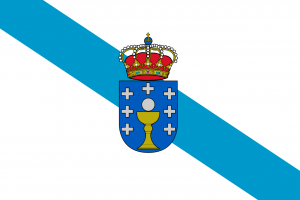Language/Galician/Grammar/Basic-Sentence-Structure
| ◀️ The Galician Alphabet — Previous Lesson | Next Lesson — Numbers 1-10 ▶️ |
Galician is a Romance language spoken in Galicia, a region located in the northwest of Spain. If you want to learn Galician, it is important to start with the basics of sentence structure. In this lesson, you will learn how to construct basic sentences in Galician, from the subject to the object.
Basic Sentence Structure
In Galician, a sentence typically follows the Subject-Verb-Object (SVO) word order. The subject is the person, animal, or thing that performs the action, the verb is the action that is being performed, and the object is the person, animal, or thing that receives the action.
Here are some basic examples:
| Galician | Pronunciation | English | ||||||
|---|---|---|---|---|---|---|---|---|
| O gato | o gato | The cat | come | ˈkome | eats | o rato | o ˈɾatu | the mouse |
| Eu | ew | I | falo | ˈfalo | speak | galego | ɡaˈleɣo | Galician |
Translation: The cat eats the mouse. I speak Galician.
As you can see, the verb always follows the subject, and the object follows the verb.
However, it's important to note that Galician is a flexible language and can use other word orders to express different shades of meaning.
For example, you can use an object-subject-verb (OSV) word order to emphasize the object of a sentence:
| Galician | Pronunciation | English | ||||||
|---|---|---|---|---|---|---|---|---|
| Os libros | oʃ liˈbɾos | The books | gústanme | ˈɡustanme | I like | moito | ˈmoito | a lot |
Translation: I like the books a lot.
You can also use a subject-verb-adverb (SVA) word order to describe how or when a certain action is performed:
| Galician | Pronunciation | English | |||||||||
|---|---|---|---|---|---|---|---|---|---|---|---|
| Nós | noʃ | We | estudamos | estuˈðamos | study | moito | ˈmoito | a lot | pronto | ˈpɾonto | soon |
Translation: We study a lot soon.
Another example of using adverbs in a sentence:
| Galician | Pronunciation | English | ||||||
|---|---|---|---|---|---|---|---|---|
| Eles | eˈles | They | comen | koˈmen | eat | ben | ˈben | well |
Translation: They eat well.
As you can see, the position of the adverb can change depending on the emphasis you want to give.
Pronouns
Pronouns are words that replace nouns in a sentence. In Galician, like in English, the most common pronouns are the subject pronouns:
| Galician | Pronunciation | English | |||||||||||||||
|---|---|---|---|---|---|---|---|---|---|---|---|---|---|---|---|---|---|
| Eu | ew | I | Ti | ti | You (singular) | El/Ela | el/ela | He/She | Nós | noʃ | We | Vós | vos | You (plural) | Eles/Elas | eles/elas | They (masculine/feminine) |
Subject pronouns are typically used to avoid repetition and make a sentence less verbose:
| Galician | Pronunciation | English | ||||||
|---|---|---|---|---|---|---|---|---|
| O meu amigo | o ˈmeu amiɡo | My friend (male) | é | e | is | intelixente. | inteliˈʃente | intelligent. |
| Él | eˈl | He | tamén | tamˈbɛn | also | é intelixente. | e inteliˈʃente | intelligent. |
Translation: My friend is intelligent. He is also intelligent.
Object pronouns, on the other hand, replace the direct or indirect object of a sentence:
| Galician | Pronunciation | English | |||||||||||||||
|---|---|---|---|---|---|---|---|---|---|---|---|---|---|---|---|---|---|
| Me | me | Me (direct object) | Ti | ti | You (singular, direct object) | Lle | ʎə | Him/Her (indirect object) | Nos | nos | Us (direct object) | Vos | vos | You (plural, direct object) | Lles | ʎəs | Them (masculine/feminine, direct object) |
Here is an example of object pronouns in a sentence:
| Galician | Pronunciation | English | ||||||
|---|---|---|---|---|---|---|---|---|
| O meu amigo | o ˈmeu amiɡo | My friend (male) | axudoume | aʃuˈdome | helped me | coas miñas compras. | koas ˈmiɲas ˈkompras | with my groceries. |
Translation: My friend helped me with my groceries.
It's important to note that in Galician, the pronoun is typically placed before the verb, unlike in English where it follows it.
Questions
To ask questions in Galician, you can invert the order of the subject and verb, or use question words such as “que”, “cando”, “onde”, “quen”, etc.
Here are some examples:
| Galician | Pronunciation | English | ||||||
|---|---|---|---|---|---|---|---|---|
| Onde | ˈonde | Where | estás? | esˈtas | are you? | |||
| Cando | ˈkando | When | xogamos? | ʃoˈɣamos | will we play? | |||
| Que | ke | What | estás | esˈtas | are you | a facer? | a ˈfatser | doing? |
Translation:
Where are you? When will we play? What are you doing?
Negative Sentences
In Galician, negating a sentence is as simple as adding the word "non" before the verb.
Here’s an example:
| Galician | Pronunciation | English | |||||||||
|---|---|---|---|---|---|---|---|---|---|---|---|
| Eu | ew | I | non | ˈnon | not | falo | ˈfalo | speak | galego | ɡaˈleɣo | Galician |
Translation: I don't speak Galician.
Conclusion
In this lesson, you have learned the basics of sentence structure in Galician, including the SVO word order, pronouns, questions, and negative sentences. You can use these concepts to start building simple sentences in Galician. In the next lessons, you will learn more about vocabulary, grammar, and pronunciation to improve your proficiency in the language.
Other Lessons
- Definite Articles in Galician
- Adjective Agreement
- Subject Pronouns
- Present Tense
- Questions
- Be Polite
- 0 to A1 Course
- Plurals
- The Galician Alphabet
Sources
| ◀️ The Galician Alphabet — Previous Lesson | Next Lesson — Numbers 1-10 ▶️ |

